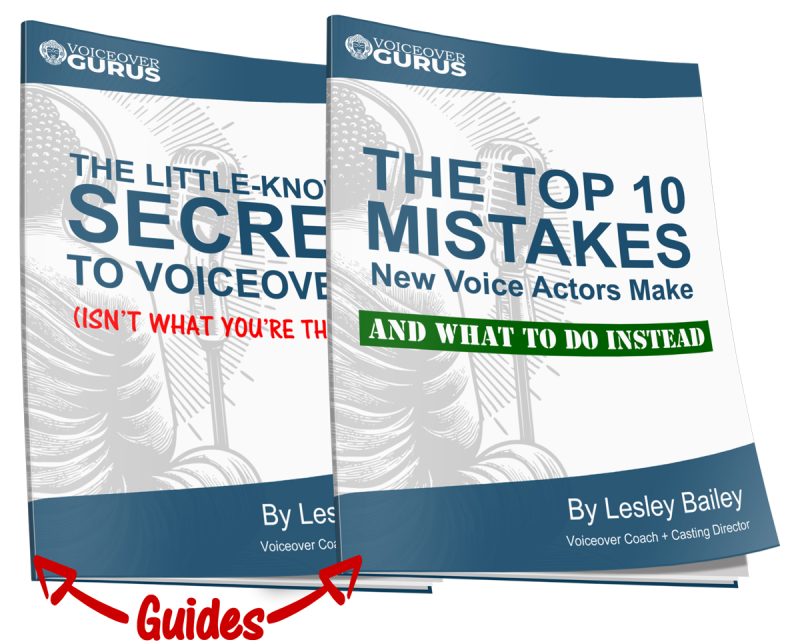
Voiceover technique comes in many shapes and forms, and you’ve most likely heard them all referred to at one time or another. If you have, please excuse this blog as a mere exercise for me to finally just organize my knowledge of the main aspects of voiceover technique. It often feels like homework to me and I am having a very brief moment of inspiration so I must act swiftly. If you’re new to the voiceover business, read on. You will begin to quickly understand the main ways in which to approach your voiceover training and comprehension of what you will need to check off your list in order to make your script approach compelling, believable, and to the point. The main checkpoints in voiceover that we will cover now are as folllows: pacing, inflection, underscoring of keywords/points, your audience, your character/personality, intention, and most importantly, understanding of and connection to the writer’s mind.
PACING: When you read a voiceover script too fast or too slow, both of these speeds will make it sound like you are reading words off a piece of paper. Words that are not your own. You have already lost the job. The simplest way to approach pacing is to start listening to everyday conversations you have. It might even be easier if you are a fly on the wall and get to just listen and observe others in the act already. Your own navel-gazing while talking might be distracting. All around you there are conversations taking place, and they are all playing out at the exact perfect pace they should because they are real. There is no pretense there. This is what you need in your own delivery so that no one will hear an “announcement.” What you have just read is about general pacing of the entire script, but there is also internal pacing which happens when actors get greedy or careless. This comes in the form of pauses at unnecessary moments in the script, or pauses where a comma directs them but in a much longer form than needed. We don’t speak in natural conversation with long pauses – we take the bare minimum we need if it’s necessary to either connect ideas or create drama. If you add too long a pause somewhere it’s not needed, you will sound like you are “performing.” If you take too short of a pause, you will sound like you are reading and running sentences or ideas together. When you record yourself, listen for the pauses and then ask yourself if they were necessary or if you could have skipped it entirely, and then correct it. Here’s a sentence where I see the mistake happen a lot: “It can when it’s the True Blue Family of Checking Products from Eastern Bank.” Almost everyone will pause after the “can” – but if you take real notice you will see that is unnecessary. It can what? It can when. No. Need. To. Pause! Stop it! Ok, enough about pacing for now. Let’s move on.
INFLECTION: Inflection is defined as the modulation of intonation or pitch in the voice. Synonyms for inflection are stress, cadence, rhythm, accent, emphasis, lilt, tone, etc. To use layman’s terms I like to refer to inflection as the high (up) and low (down) tones of how you say a word. We’re gonna go over the “general” ways people use inflection in everyday speech and the emotional tone it conveys, but keep in mind this is one of those rules that will get broken given a specific context. No I can’t think of a context right now. Sorry. The right voiceover script will reveal its needs to you and you will just know. But generally speaking, here’s how we use a high/up inflection: to convey friendliness, openness, excitement, positivity, to convince, to question, to incite. We need these things in a voiceover performance or we won’t sound accessible, likeable, relatable. Too much of this inflection choice, however, will result in sounding like you’re trying too hard, trying to convince. As for the low/down inflection, we use this to convey: confidence, absolute certainty, no ifs-ands-or-buts about it, warmth, sincerity, intelligence. Too much of this inflection will have you sounding flat, serious, cocky. But for the most part, this is not only the trending inflection choice but the one that makes the most sense. We use this inflection choice when we know what we are talking about. This is what any strong leader/representative needs more of.
UNDERSCORING/EMPHASIZING KEY WORDS AND KEY POINTS: This one is pretty critical. This one truly allows you to sound engaged, to sound like you know what you’re saying and what your purpose is. This one tells the writer you “get it.” The emphasizing of what’s important in the voice over script, in each and every sentence, comes from script analysis. I am AMAZED how many people literally look at a script and start reading and performing it out loud without having done any contemplative inward reading/analysis first. This can only result in one thing, and yes I have said it before a thousand times – sounding like you are reading. Well, that’s what you are doing yes? Until you stop reading and start understanding, you will always be an amateur. Think about what we do when reading an article or a novel – we UNDERSTAND, we ABSORB, we FEEL. Yes this is harder to do with the emotional vacuum that a voiceover can many times be, but what else can we do? We must find the connection, the meaning, anything…..an intention from the writer in his message. Each and every sentence has a point. Take this sentence for example – “ What if the spoon and the lid dripped back into the saucepan?” I ask students all the time what the most important word is here and the answer has run the gamut. I will refute them now.
If – Really?
Dripped – In context maybe, but alone can be negative. So, there’s got to be better.
Spoon and/or lid – What about them? Other companies make those too.
Saucepan – see spoon and lid.
Back – Not bad, not bad. This speaks to why this product is better than others. But back where? Where?
INTO. That’s where. This product is superior because it’s saucepan has the sauce dripping back INTO it’s pot, not out of it and all over the stovetop.
This is what you must do on EVERY SINGLE SENTENCE. If you don’t get it, you won’t “get” it.
YOUR AUDIENCE: Who is this product being marketed to? Who are you talking to? Who in your life do you know who fits this target market? Pick that person and literally visualize them in front of you. Take it steps further – where are you? What are you both wearing? Are you at a restaurant? Living room? Sharing coffee or a beer? Walking in the park? Get a feel for the tone of the script and use your best judgement there. When you place yourself somewhere with someone you now have a level of reality and you gotten further away from the microphone, from “reading.” This level of imagination and intention will go as far as any mechanical technique and probably further. It is the tip of the iceberg into the actual acting part of voice-acting. That’s another blog article entirely.
YOUR CHARACTER/PERSONALITY: HOW are you going to read this voiceover script? What personality traits will you embody? The adjectives will likely be given to you by the writer in the form of “specs.” Let’s just always operate as if you are NOT being given a description of how they want this performed and you must figure it out for yourself. How will you do that? Reading the script. Again and again. Until you “get it.” There is information given in the script – “the McRib is back at McDonalds for a limited time.” And there is the “other stuff.” – This is the stuff the writer uses as his creative tool for building a “story” around the information. Take that word “story”with a grain of salt, as often it is not so much a story as it is a brief essence of the personality of the person delivering the information. So after the information (McRib is back….) comes the personality – “You’re welcome.” What kind of person gives you good news and then says that? Is it someone warm, friendly, smart? No – it’s someone wry, sarcastic, confident, playful. So that’s what you must be because clearly that’s what the writer wants. Take the sentence, “They’re simple solutions, but if you think about it, it makes for a much smarter kitchen.” Who are you there? I’m going to go with a “thinker”, an “improver”, an “intellectual.” Any guess is better than no guess. Any guess puts you at the human being level, much better than the “reading a script” level. The writer always leaves clues as to your character. Investigate and discover them. They are your tool for bringing the script to something beyond just information-giving. They give YOU life.
INTENTION: William Esper said that “truth is the blood of acting.” After all the voiceover techniques you have learned so far, none come close to the power of connecting with your intention . . . connecting with the truth. Yes, there are a lot of crummy voiceover scripts out there, and not a lot of emotional connection to be had – but within every script is a writer. A real human being who wrote some thing from some place of truth. Find it and it’s yours to embrace and bring to life. Having trouble finding your exact intention? Make your go-to intention that of BEING CONVINCED, not trying to convince. Read from a place of conviction and you can’t go wrong. Understand the script even better than that, and you’ll do even more than “can’t go wrong.”
THE WRITER’S MIND: Analyzing the voiceover script gets you inside the writer’s mind. The writer is one of the key players in deciding the winning voice. Many of the previous sections you have just read (especially key words/points) all speak to the writer’s mind and giving the writer exactly what he has imagined in his own head. The only last piece of info to remember here is that the MESSAGE is not to be confused with the STRUCTURE. The message comes from the product people, and that is not where the writer works. The writer works at BBDO, not McDonald’s. The message is about McDonald’s, so remember that to connect with the WRITER, you need to see how he actually structured the message. Same message, but two different writers could deliver in very different ways. Remember you are auditioning for the writer and you’re getting closer already to connecting with the important part of the script – the style.
These pillars of voice over technique will never change. They are the foundation for nailing the meaning, personality, and message at the heart of any voiceover script. Voiceover trends, on the other hand, will speak to the industry and how it operates, and it’s great to keep up with that revolving door and how it’s swinging. You’ve got your work cut out for you.


 Hi! I’m Lesley Bailey. I’m an award-winning Casting Director, Voiceover Coach, Demo Producer, and Consultant with over 30 years “in the trenches”. I love helping voice actors bring scripts to life with authenticity and confidence.
Hi! I’m Lesley Bailey. I’m an award-winning Casting Director, Voiceover Coach, Demo Producer, and Consultant with over 30 years “in the trenches”. I love helping voice actors bring scripts to life with authenticity and confidence.